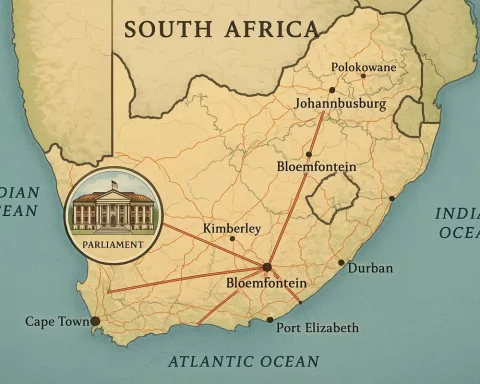South Africa’s Hex Project is the country’s first Battery Energy Storage System (BESS), located in the Western Cape, and represents a major breakthrough in Africa’s energy sector. Spearheaded by Eskom, the state-owned power corporation, the initiative aims to combat the global climate crisis by reducing greenhouse gas emissions, creating job opportunities, securing investments, and enhancing living standards for South Africans. The Hex project is not only a remarkable engineering achievement, but also serves as a beacon of hope for a sustainable future.
What is South Africa’s Hex Project and what does it mean for a sustainable future?
The Hex Project is Africa’s first Battery Energy Storage System (BESS), located in South Africa’s Western Cape. The initiative is spearheaded by Eskom, the state-owned power corporation, and represents a significant breakthrough in Africa’s energy sector. The Hex project goes beyond being a remarkable engineering accomplishment, aiming to combat the global climate crisis by curbing greenhouse gas emissions. Furthermore, it aims to create job opportunities, secure investments, and enhance living standards for South Africans, while also serving as a stepping stone towards a sustainable future.
The Dawn of A New Era
Centrally located in South Africa’s Western Cape, Worcester takes pride in being the venue for a significant technological breakthrough—Africa’s inaugural Battery Energy Storage System (BESS), known as the Hex project. Spearheaded by the state-owned power corporation, Eskom, the Hex battery system’s initiation denotes a critical juncture in Africa’s energy sector.
The Hex project is a radiant symbol of progress and creativity. It acknowledges the resilience and flexibility of Eskom and the South African Government in devising a lasting power supply amidst the prevailing obstacles of load shedding. This initiative resonates with the global drift towards renewable energy and the quest for energy stability in a world that’s wrestling with climate change.
During the unveiling, Minister Pravin Gordhan praised the project’s importance, envisioning a future where increased implementation of such initiatives could potentially eradicate load shedding. He envisaged a future where Eskom’s dedication to innovation and delivery, coupled with consistent backing from the African Development Bank, the World Bank, and the New Development Bank, could radically transform the energy scenario of South Africa and indeed, Africa as a whole.
More than an Engineering Marvel
The Hex project goes beyond being a remarkable engineering accomplishment. It’s a beacon of hope ensuring increased economic prosperity for the nation. It sends a strong message to prospective investors that South Africa, despite load shedding challenges, is steadily surmounting hurdles and is primed for investment.
The BESS also exemplifies South Africa’s pledge to inclusive economic expansion. It mirrors the nation’s cognizance of the crucial role of electricity in contemporary life and its drive to guarantee energy security. It’s not merely about catering to the current energy demands, but also about building a surplus—an energy buffer for future generations.
The Hex battery energy storage system encompasses more than just electricity provision. It’s about job creation, securing investments, and enhancing living standards. It’s an initiative that influences 62 million South Africans—the recently updated population figure—who reap the benefits of such forward-thinking ventures.
Addressing Global Climate Crisis
In addition, the BESS signifies South Africa’s dedication to combating the global climate crisis. It offers a concrete answer to the worldwide appeal for decarbonisation—curbing greenhouse gas emissions. The project is in line with South Africa’s Integrated Resource Plan and the global dedication to a Just Energy Transition, focusing on the transition from fossil fuel-based energy to renewable sources.
The Hex project isn’t a solitary endeavour but forms a part of broader transformations occurring in South Africa, all aimed at crafting a sustainable and prosperous future. It serves as a stepping stone towards a greener, more resilient South Africa—one that is prepared to tackle climate change challenges head-on.
Moreover, it’s not restricted to Worcester. The Hex project is the opening chapter, acting as a blueprint for similar initiatives to be implemented across the nation, including the Northern Cape, Eastern Cape, and KwaZulu-Natal. It’s about a nation ready to share its wisdom and victories with the rest of the continent and the globe.
Looking Towards the Future
As South Africa embarks on a journey powered by renewable energy, the Hex project stands as a tribute to the nation’s capacity to not only dream but to actualize those dreams. It signals a fresh age of energy self-reliance, economic wealth, and sustainable growth for South Africa.
Minister Gordhan’s celebratory speech also served as a reminder of the wider context. He discussed South Africa’s role in global climate change negotiations and the country’s commitment to decarbonisation. He underscored the necessity for developed nations to extend more support to developing countries like South Africa to enable affordable, climate-friendly initiatives.
He championed the dissemination of climate-related technology, proposing it become a public resource, accessible to all. The BESS project propels this vision closer to reality, proving that innovation and execution can work together.
The launch of the Hex project signifies more than a battery storage system—it’s a declaration of intent. It’s South Africa standing tall, demonstrating to the world its readiness to face future challenges. It’s about resilience, innovation, and most importantly, hope—a hope that reverberates through Worcester’s valleys and the soul of South Africa, marking the advent of a new epoch in energy security for the continent.
1. What is South Africa’s Hex Project?
The Hex Project is Africa’s first Battery Energy Storage System (BESS), located in South Africa’s Western Cape. The initiative is spearheaded by Eskom, the state-owned power corporation, and represents a significant breakthrough in Africa’s energy sector.
2. What is the significance of the Hex Project for a sustainable future?
The Hex project goes beyond being a remarkable engineering accomplishment, aiming to combat the global climate crisis by curbing greenhouse gas emissions. Furthermore, it aims to create job opportunities, secure investments, and enhance living standards for South Africans, while also serving as a stepping stone towards a sustainable future.
3. What does the Hex project represent for South Africa’s energy sector?
The Hex project denotes a critical juncture in Africa’s energy sector and acknowledges the resilience and flexibility of Eskom and the South African Government in devising a lasting power supply amidst the prevailing obstacles of load shedding.
4. How does the Hex project benefit the economy?
The BESS also exemplifies South Africa’s pledge to inclusive economic expansion. It sends a strong message to prospective investors that South Africa, despite load shedding challenges, is steadily surmounting hurdles and is primed for investment. Moreover, it offers job creation, securing investments, and enhancing living standards.
5. What is the significance of the Hex project in addressing the global climate crisis?
The Hex project signifies South Africa’s dedication to combating the global climate crisis and offers a concrete answer to the worldwide appeal for decarbonisation—curbing greenhouse gas emissions. It is in line with South Africa’s Integrated Resource Plan and the global dedication to a Just Energy Transition.
6. What is the future of the Hex project?
The Hex project is not restricted to Worcester. It is the opening chapter, acting as a blueprint for similar initiatives to be implemented across the nation, including the Northern Cape, Eastern Cape, and KwaZulu-Natal. It serves as a stepping stone towards a greener, more resilient South Africa—one that is prepared to tackle climate change challenges head-on.








